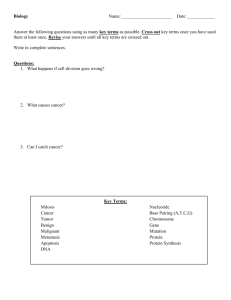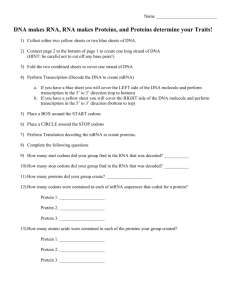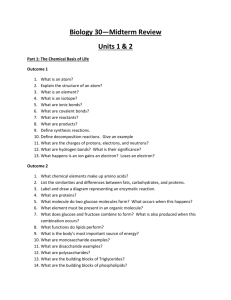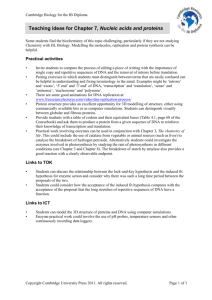CST Review - Central Dogma Of Biology
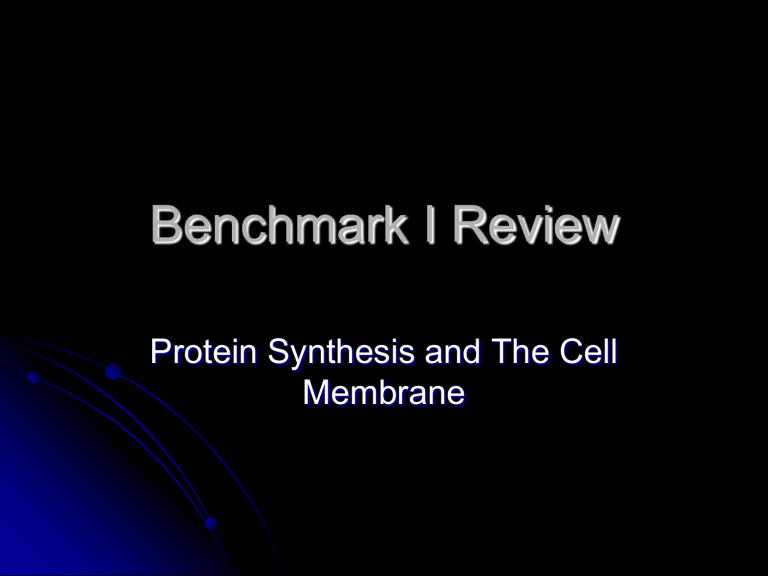
Benchmark I Review
Protein Synthesis and The Cell
Membrane
Part I. Protein Synthesis
(Review) DNA Basics
Double helix=twisted ladder
Chromosomes=chains of DNA and proteins.
Contains your genetic info (instructions to make proteins)
Sequences of DNA=Genes
Genes=codes for proteins=instructions for traits
Protein Synthesis -Standards:
BI1. d. Students know the central dogma of molecular biology outlines the flow of information from transcription of ribonucleic acid (RNA) in the nucleus to translation of proteins on ribosomes in the cytoplasm.
BI4. a. Students know the general pathway by which ribosomes synthesize proteins, using tRNAs to translate genetic information in mRNA.
BI5. a. Students know the general structures and functions of DNA, RNA, and protein.
BI5. b. Students know how to apply base-pairing rules to explain precise copying of DNA during semiconservative replication and transcription of information from DNA into mRNA.
Protein Synthesis –Standards
Explanation:
BI4. a. Students know the general pathway by which ribosomes synthesize proteins, using tRNAs to translate genetic information in mRNA.
4.a.-ribosomes make proteins by reading a mRNA message,which has a code for a specific protein.
BI5. a. Students know the general structures and functions of DNA,
RNA, and protein.
5.a.-DNA-double helix-contain genetic info, RNA-single-stranded, copy of a section of DNA, protein-make up many parts of the body
BI5. b. Students know how to apply base-pairing rules to explain precise copying of DNA during semiconservative replication and transcription of information from DNA into mRNA.
5.b.-DNA-(A-T, C-G), RNA-(A-U, C-G, (T)-A)
What is the central dogma?
The central dogma describes the flow of information from DNA to RNA to proteins.
DNA, Genes, and Protein
Synthesis
Your traits are determined by your DNA because your DNA has codes/instructions for your traits called genes . Genes contain the codes for proteins , which make-up many structures such as your fingernails, hemoglobin, muscles, and the color of your eyes. The process of converting the instructions for your traits from your genes into protein molecules is called protein synthesis .
Key Concepts for Protein Synthesis
Replication-DNA replication copies the genetic info of a cell.
Transcription-converts a gene into a single-stranded RNA molecule.
Translation-converts an mRNA message into a polypeptide, or protein.
Protein Synthesis Pathway-DNA->mRNA-
>tRNA->proteins
What happens when protein synthesis doesn ’ t work
properly?(Mutations)
By changing the DNA sequence we are changing the “ instructions ” for proteins and this can change an organism at the molecular level causing a mutation . This is similar to what happens when you change a step in a recipe or alter the reading frame in a sentence. These changes alter the product.
Gene Mutations
Changes in a single gene
Point mutations=occur at a single point in the nucleotide, change one amino acid in a protein, substitution (most common)
Frameshift= insertion or deletion of a nucleotide, shift reading frame of amino acids, alters function of proteins
Part II.
The Cell Membrane
Standard Explanation
1a.)Students know cells are enclosed within semipermeable membranes that regulate their interaction with their surroundings.
Explanation: The cell membrane allows molecules to enter and leave the cell to maintain the internal balance of the cell.
The Cell Membrane
Semi-permeable-allows some molecules to pass through.
Function-To regulate the movement of molecules into and out of the cell.
Made of phospholipids (bi-layer), proteins, and carbohydrates.
Summary Questions
What occurs during transcription?
-the DNA strand is turned into an RNA strand
What occurs during translation?
-The ribosome reads the codon on the mRNA strand and makes a protein
How are mutations caused?
-A single change in genetics
What is the function of the cell membrane?
-controls what comes in and out of the cell
(semipermiability)


